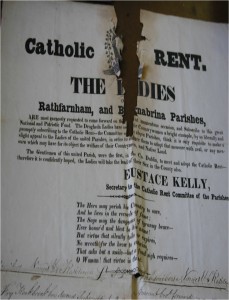Ambiguity
Published in
Uncategorized

A handbill addressed to the ladies in the parishes of Rathfarnham and Bohernabreena, Co. Dublin, urging them to support the call for Catholic Emancipation. (Dublin Diocesan Library)
Haverty’s painting and the engraving convey an ambiguous message concerning women’s involvement in the Repeal movement. The shawled woman in the painting seems as interested in the political message as the men standing beside her, while other women are given more traditional or symbolic roles as female relatives or as mothers caring for infants and young children. Despite the paradoxical visual message, women were clearly involved in the political organisations founded by Daniel O’Connell. Their most visible role in the Catholic Association was as fund-raisers or collectors of the ‘Catholic Rent’. In the 1820s, separate ‘Ladies Committees’ were formed to encourage women to collect a ‘Ladies’ Catholic Rent’. Among the papers of the Catholic Association in the Dublin Diocesan Library is a handbill addressed to the ladies in the parishes of Rathfarnham and Bohernabreena, Co. Dublin, urging them to support the call for Catholic Emancipation.

